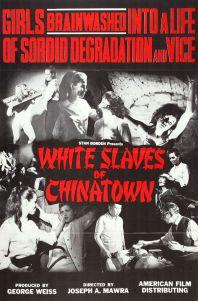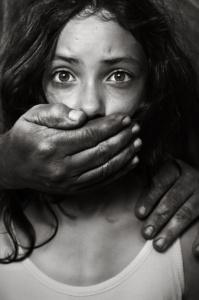To what extent is the criminalization of prostitution in the U.S. tied into racism? Obviously it’s not hard to trace the connection between the War on Drugs and racism, and the relationship between skin-color and enforcement of prostitution laws is obvious. It’s also easy to notice that prostitution starts to become illegal not long after the Civil War, but to what extent does that relate to race, if at all?
 Though the most pernicious form of racism in the modern US is that directed against black people, the country has a long and ugly history of bigotry against others as well (consider, for example, the literally genocidal racism inflicted on American Indians). So while you’re correct that the criminalization of sex work in the US is indeed rooted in racism, the specific culprit which started the ball rolling was racism against Asian people, specifically the Chinese. As I explained in my “Brief History of Prostitution in the US“,
Though the most pernicious form of racism in the modern US is that directed against black people, the country has a long and ugly history of bigotry against others as well (consider, for example, the literally genocidal racism inflicted on American Indians). So while you’re correct that the criminalization of sex work in the US is indeed rooted in racism, the specific culprit which started the ball rolling was racism against Asian people, specifically the Chinese. As I explained in my “Brief History of Prostitution in the US“,
…When Chinese immigrants began to pour into California…white Americans feared these new arrivals whose ways were so different from their own…most female Chinese immigrants of the time were either prostitutes or second wives in polygamous marriages, so in 1875 Congress passed the Page Law, which banned the immigration of women for “lewd and immoral purposes”. In a way, the law backfired; Chinese men flooded into the country anyway (especially into California and New York), and since there was a shortage of Chinese women, many of them either patronized white prostitutes or set up small brothels and hired them; others married or cohabited with working-class white women. The self-appointed guardians of public morality were scandalized, and the seeds of moral panic were sown…
The Page Law was only the first of many federal, state and local “morality” laws inflicted on sex workers, and while many of them were based in the imagined “inferiority” of non-Europeans, full-on criminalization was based in the imagined “superiority” of white Europeans:
…The existence of prostitutes required considerable cognitive gymnastics to reconcile with the Victorian view that women were intrinsically asexual…[most scholars believed] that prostitutes represented regressions to a more “primitive” type of woman. This racist view could be used to explain away non-European sex workers or those of supposedly “degraded” nationalities, but those involved in the increasingly popular “rescue” movement soon discovered to their horror that there were more than a few Anglo-Saxon prostitutes, including some middle-class girls of “good breeding” and education. It was therefore proposed that white prostitutes “had…fallen into the hands of ‘professional seducers’, who had manipulated their sexless victims into submission.” This narrative of helpless young white women forced into a life of exploitation, had tremendous popular appeal; it was heavily promoted from the 1880s on by organizations like the Salvation Army and found especially fertile soil in areas where white prostitutes worked alongside those of other ethnicities or catered to a nonwhite clientele. The myth of “white slavery” (as it was then called) also appealed to middle-class discomfort with female autonomy; if women who traveled large distances and made their way by either casual or professional prostitution could be cast as the victims of evil men, there was no need to rethink the notion of female helplessness…Like all moral panics, the “white slavery” hysteria thus cast a challenge to prevailing social norms as a threat from outside forces to be fought…
 Of course, once prohibition of sex work was in place, it was enforced disproportionately against poor people and ethnic minorities, especially black people, just as all prohibitionist laws are (which is why I’ve repeatedly argued that support for any prohibition is a sign of naivety and, though I find it a very flawed term, privilege). The Mann Act of 1910 (or to give it its official name, “The White-Slave Traffic Act”), the first federal anti-prostitution law specifically worded as such, was notorious for its use in persecuting black men involved in relationships with white women. The modern recycling of the old “white slavery” hysteria, the “sex trafficking” panic, has spawned a whole host of laws which are disproportionately employed against young black and Latino men, especially those belonging to what the “authorities” label “gangs”. And just as in the past, interracial relationships are an especial target of busybodies looking for “signs of sex trafficking” or even just plain prostitution.
Of course, once prohibition of sex work was in place, it was enforced disproportionately against poor people and ethnic minorities, especially black people, just as all prohibitionist laws are (which is why I’ve repeatedly argued that support for any prohibition is a sign of naivety and, though I find it a very flawed term, privilege). The Mann Act of 1910 (or to give it its official name, “The White-Slave Traffic Act”), the first federal anti-prostitution law specifically worded as such, was notorious for its use in persecuting black men involved in relationships with white women. The modern recycling of the old “white slavery” hysteria, the “sex trafficking” panic, has spawned a whole host of laws which are disproportionately employed against young black and Latino men, especially those belonging to what the “authorities” label “gangs”. And just as in the past, interracial relationships are an especial target of busybodies looking for “signs of sex trafficking” or even just plain prostitution.
Finally, racism has played a major role in the spread of “sex trafficking” hysteria in Europe; it’s easy to see how the xenophobia and hysteria grew as the major origin points for emigration to Western Europe shifted from Eastern Europe to the Balkans to the Middle East to Africa. The darker the skin of the migrants, the greater the panic increased and the more those migrants were infantilized and those who assist in their migration demonized. In the US, I feel that the primary driver of the current moral panic is anti-sex hysteria, fueled by reaction to the sexual revolution, the HIV epidemic & gains in rights for sexual minorities rather than ethnic ones (which is why one of the groups disproportionately persecuted under anti-prostitution laws is transwomen). But both the hysteria itself, and the way in which it is enforced by “authorities”, are powerfully shaped by the racism and xenophobia from which criminalization first sprang.
